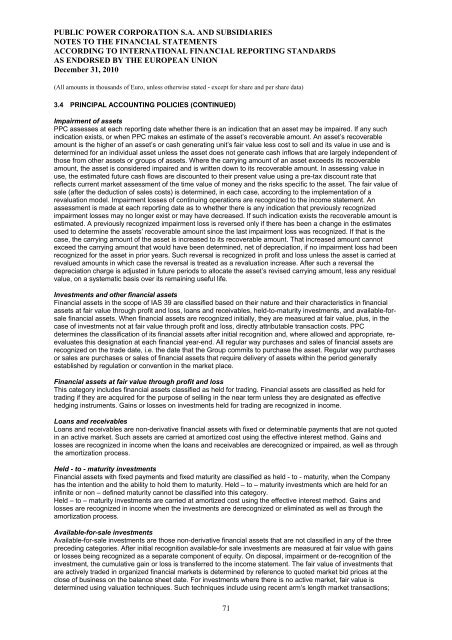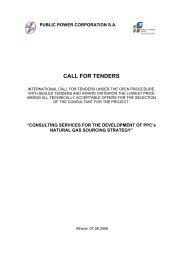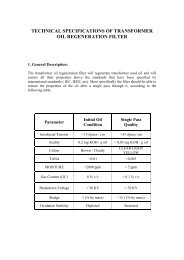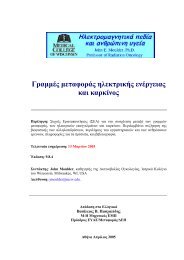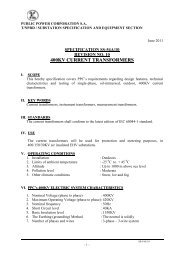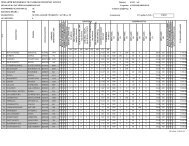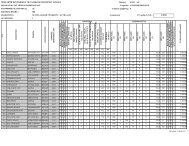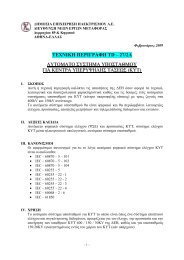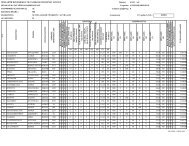Financial Report (January 1, 2010 - December 31, 2010)
Financial Report (January 1, 2010 - December 31, 2010)
Financial Report (January 1, 2010 - December 31, 2010)
Create successful ePaper yourself
Turn your PDF publications into a flip-book with our unique Google optimized e-Paper software.
PUBLIC POWER CORPORATION S.A. AND SUBSIDIARIESNOTES TO THE FINANCIAL STATEMENTSACCORDING TO INTERNATIONAL FINANCIAL REPORTING STANDARDSAS ENDORSED BY THE EUROPEAN UNION<strong>December</strong> <strong>31</strong>, <strong>2010</strong>(All amounts in thousands of Euro, unless otherwise stated - except for share and per share data)3.4 PRINCIPAL ACCOUNTING POLICIES (CONTINUED)Impairment of assetsPPC assesses at each reporting date whether there is an indication that an asset may be impaired. If any suchindication exists, or when PPC makes an estimate of the asset’s recoverable amount. An asset’s recoverableamount is the higher of an asset’s or cash generating unit’s fair value less cost to sell and its value in use and isdetermined for an individual asset unless the asset does not generate cash inflows that are largely independent ofthose from other assets or groups of assets. Where the carrying amount of an asset exceeds its recoverableamount, the asset is considered impaired and is written down to its recoverable amount. In assessing value inuse, the estimated future cash flows are discounted to their present value using a pre-tax discount rate thatreflects current market assessment of the time value of money and the risks specific to the asset. The fair value ofsale (after the deduction of sales costs) is determined, in each case, according to the implementation of arevaluation model. Impairment losses of continuing operations are recognized to the income statement. Anassessment is made at each reporting date as to whether there is any indication that previously recognizedimpairment losses may no longer exist or may have decreased. If such indication exists the recoverable amount isestimated. A previously recognized impairment loss is reversed only if there has been a change in the estimatesused to determine the assets’ recoverable amount since the last impairment loss was recognized. If that is thecase, the carrying amount of the asset is increased to its recoverable amount. That increased amount cannotexceed the carrying amount that would have been determined, net of depreciation, if no impairment loss had beenrecognized for the asset in prior years. Such reversal is recognized in profit and loss unless the asset is carried atrevalued amounts in which case the reversal is treated as a revaluation increase. After such a reversal thedepreciation charge is adjusted in future periods to allocate the asset’s revised carrying amount, less any residualvalue, on a systematic basis over its remaining useful life.Investments and other financial assets<strong>Financial</strong> assets in the scope of IAS 39 are classified based on their nature and their characteristics in financialassets at fair value through profit and loss, loans and receivables, held-to-maturity investments, and available-forsalefinancial assets. When financial assets are recognized initially, they are measured at fair value, plus, in thecase of investments not at fair value through profit and loss, directly attributable transaction costs. PPCdetermines the classification of its financial assets after initial recognition and, where allowed and appropriate, reevaluatesthis designation at each financial year-end. All regular way purchases and sales of financial assets arerecognized on the trade date, i.e. the date that the Group commits to purchase the asset. Regular way purchasesor sales are purchases or sales of financial assets that require delivery of assets within the period generallyestablished by regulation or convention in the market place.<strong>Financial</strong> assets at fair value through profit and lossThis category includes financial assets classified as held for trading. <strong>Financial</strong> assets are classified as held fortrading if they are acquired for the purpose of selling in the near term unless they are designated as effectivehedging instruments. Gains or losses on investments held for trading are recognized in income.Loans and receivablesLoans and receivables are non-derivative financial assets with fixed or determinable payments that are not quotedin an active market. Such assets are carried at amortized cost using the effective interest method. Gains andlosses are recognized in income when the loans and receivables are derecognized or impaired, as well as throughthe amortization process.Held - to - maturity investments<strong>Financial</strong> assets with fixed payments and fixed maturity are classified as held - to - maturity, when the Companyhas the intention and the ability to hold them to maturity. Held – to – maturity investments which are held for aninfinite or non – defined maturity cannot be classified into this category.Held – to – maturity investments are carried at amortized cost using the effective interest method. Gains andlosses are recognized in income when the investments are derecognized or eliminated as well as through theamortization process.Available-for-sale investmentsAvailable-for-sale investments are those non-derivative financial assets that are not classified in any of the threepreceding categories. After initial recognition available-for sale investments are measured at fair value with gainsor losses being recognized as a separate component of equity. On disposal, impairment or de-recognition of theinvestment, the cumulative gain or loss is transferred to the income statement. The fair value of investments thatare actively traded in organized financial markets is determined by reference to quoted market bid prices at theclose of business on the balance sheet date. For investments where there is no active market, fair value isdetermined using valuation techniques. Such techniques include using recent arm’s length market transactions;71


